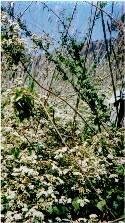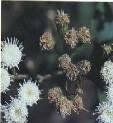Castle Gorge is unlucky enough to have several patches of this weed which seem to be in the fairly early stages of a major eruption into South Africa. It is quite closely related to the notorious Chromolaena (paraffin or triffid weed) that has wrecked so much of KwaZulu Natal's wild places. Crofton weed needs to be stamped out now - before it becomes another lost battle!
 |
 |
|
Crofton weed originates from South America and has become a major pest in Australia, where it escaped from cultivation in about 1900. It has become particularly widespread in coastal areas and has been declared a noxious plant over there. This is what the Australians tell us about it:
'Crofton weed and its close relative mistflower (A. riparia) infests large areas of the coast, especially steep, well-drained land where annual rainfall is more than 1500mm and where there is little or no frosting. The weed has been present in the Sydney region for more than 30 years and has spread rapidly in this area since the early 1970s. It is now a problem weed, especially on small farms where horses are kept.
Its seeds spread rapidly. Mature Crofton weed plants can produce between 10 000 to 10 000 seeds per year. Seeds are very light (25 000 seeds/g) and are windborne over long distances to invade previously uninfested areas.
The seeds require light to stimulate germination so that invasion commonly takes place on bare, disturbed sites and only rarely on heavily-vegetated areas. Once estaglished, though, seedlings tolerate shade and grow rapidaly. In this way, small infestations of Crofton weed rapidly increase in size unless controlled.
Crofton weed reduces the ecological value of bush-land, reduces crop yields and reduces the carrying capacity of grazing land. Crofton weed spread rapidly during the 1940s and 1950s and it was reported that in some areas dairy farmers and banana growers abadoned their holdings!'
Biocontrol methods are being investigated (hopefully you will find galls on the stems of the Castle Gorge plants - and hopefully these will be the result of infestation by a gall fly specially introduced to help control this evil plant!) but a useful manual control approach is to remove flowering stems in August before seed set - and seed shedding - takes place in early October.